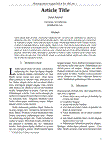| Sumario: | The permanent increase in the costs of raw materials and the difficult secure supply, such as fish meal, has led to the industry to seek more flexible and low-cost processes that will allow a sustainable business in time. In addition a limited availability of water for the sustainable farming of shrimp, has routed this business to intensive raise where the levels of pollution play a very important role. This is why the feed must also generate lower levels of waste.It is well known that the extrusion process compared with the pelleting process, produce better nutritional quality feed, but in the particular case of shrimp, where a feed of high density and stable in the water is required, the extrusion by itself is not able to achieve these levels of desired density.The main characteristics of the shrimp feed are:- Water Stability, Digestibility, Quick sinking, Smaller size of the pellet, Reduces pollution in the water, - Lowering costs in the feed and OtherAlthough the extrusion process requires a highest investment and also the operational costs are higher than the pelleting process, if the extrusion process has the appropriate technology for densification, it would be much cheaper with a much greater profit than the pelleting process and most importantly, with a better quality feed as a result.In this work we show the latest technological advances in this direction to achieve a feed for shrimp in high quality and low cost through the extrusion process.
|
|---|
